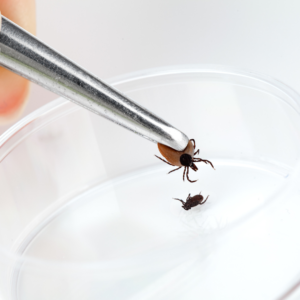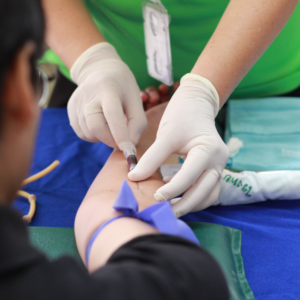Many have asked, “Is chronic Lyme disease real?” We are here to tell you that it is not only real, but it is destroying people’s lives. Many suffering from chronic Lyme have been searching for treatment for years and wondering if a cure will ever be found.
In this article, we will tell you everything you need to know about chronic Lyme and how you can better manage your chronic symptoms:
Is chronic Lyme disease real?
 Sometimes referred to as “post-treatment (or late stage) Lyme disease syndrome/symptoms,” chronic Lyme disease occurs unexplainably in some patients despite traditional Lyme treatment. Untreated Lyme disease can cause these chronic symptoms. It can also occur when Lyme was not treated properly or quickly enough.
Sometimes referred to as “post-treatment (or late stage) Lyme disease syndrome/symptoms,” chronic Lyme disease occurs unexplainably in some patients despite traditional Lyme treatment. Untreated Lyme disease can cause these chronic symptoms. It can also occur when Lyme was not treated properly or quickly enough.
Lasting symptoms of pain, fatigue, cognitive and neurological issues (just to name a few) are all results of chronic Lyme disease.
Can Lyme symptoms come back after treatment?
Yes, Lyme disease symptoms can return after treatment. Many are still in pain after a round of antibiotics, while some people feel better, only to feel worse later down the line. In some cases, symptoms appear years after being bitten/never known they were bitten. These symptoms refer to chronic Lyme disease.
What is typical Lyme treatment?
If you are diagnosed with Lyme disease, your doctor will recommend that you receive a round of antibiotics. However, Lyme becomes chronic when antibiotics do not remove all of the Lyme bacteria present in the body. Prolonged use of antibiotics is not only ineffective, but can do more harm than good. For this reason, many Lymies are forced to find other avenues of treatment.
What tests are available for Lyme disease?
Your typical testing includes a two-part blood test (but the same blood sample can be used for both parts.)
- Enzyme-linked immunosorbent assay (ELISA) test
Tests for the antibodies against Lyme bacteria. If the test is negative, no further testing is recommended. If the test is positive or unclear, the second test confirms. This means that a person may not ever be administered a second test. - Western blot test
Tests for antibodies and looks for reaction to panel of 10 proteins found on Lyme bacteria. Five of these bands reporting positive indicate an overall positive test result.
These tests are often not as helpful, though, because they frequently result in false positives and false negatives. (ELISA is falsely negative 50% of the time). If it looks like your central nervous system has been affected, your doctor may take a sample of cerebrospinal fluid from your lower back.
If you suspect you have Lyme, regardless of a positive test or not, continue to pursue treatment and get tested again, if necessary.
Sam tested negative for Lyme but was adamant about getting the treatment he needed.
There is no definitive test for post-Lyme disease/chronic Lyme symptoms, according to Johns Hopkins.
It should also be noted that there are other tests in development that have not been officially approved by the CDC. Be careful in deciding to participate in research tests and at-home tests.
If you are aware of being bitten by a tick, you can also send your tick in for testing to indicate whether or not the tick was infected when it bit you.
Do I really need a Lyme disease test?
Our advice is to always consult with your physician. However, there are times where a Lyme test may not be necessary. For instance, if you have the classic bullseye rash, have flu-like symptoms and have been exposed to ticks, then you should move forward with treatment and skip out on the expensive tests (over $200.)
However, if you believe you have been exposed to ticks and are having aches and pains, then testing could provide much needed clarity.
What Lyme disease treatments are available?
Your doctor will typically prescribe antibiotics to cure Lyme. In addition, there are many natural and alternative treatments available. (See below)
How long are Lyme disease treatments?
Your doctor will normally prescribe you a round of antibiotics spanning from about 10-21 days to treat Lyme disease. However, many people continue to have symptoms post-antibiotic treatment. After initial treatment of antibiotics, continued treatment can take years.
Antibiotics aren’t working. What should I do now?
Research shows that prolonged use of antibiotics is not only ineffective when it comes to treating chronic Lyme but can also cause other health issues.
Many turn to natural ways to cure their Lyme disease which include supplements such as:
- vitamin B- 1
- vitamin C
- fish oil
- alpha lipoic acid
- Magnesium
- chlorella
- cat’s claw
- garlic
- olive leaf
- turmeric
- glutathione
and essential oils, hyperbaric oxygen therapy, chelation therapy, saunas, UV light, electromagnetic therapy—the list goes on and the research is limited. (Healthline)
What should I expect during Lyme disease treatments?
You should expect to go through a period of feeling worse before you feel better. Herxing (Jarisch-Herxheimer reaction) refers to the spike of killing off of Lyme bacteria in the body and the toxins released during that process. While everyone is different, some HERX reactions are: fatigue, aches, flu symptoms, bloating, numbness, neck and back pain.
Where can I find a Lyme doctor?
After considering all of your options, look for doctors who are considered “Lyme literate” doctors. Some people find success with infectious disease specialists or with naturopaths. Unfortunately, where you live may dictate the availability of doctors trained to treat Lyme. You’ll come across doctors who mean well, but are not equipped with the skills to recognize Lyme. Often misdiagnosed and confused with other diseases, many doctors are hesitant to treat for Lyme because of the harmful effect antibiotics can have on the body if it ends up being another disease. However, be wary of those who are too aggressive in their treatment, but be sure to find a doctor who listens and takes your aches and pains seriously.
How much does Lyme disease treatment cost?
“Fun” fact: Lyme treatment costs up to $1.3 per year to treat (essentially $3,000 per patient), according to a 2015 Johns Hopkins study. We imagine this number has only been increasing in the past years.
While it varies for everyone, Lyme treatment (and diagnosis) can cost thousands (usually out of pocket).
Lyme disease treatment cost really depends on your insurance, though. Most insurance companies do not continue to pay for treatment past the initial round of antibiotics because they do not recognize chronic Lyme as a real disease. If you are convinced you have Lyme, but your doctor and tests say otherwise, you may find yourself paying out of pocket for this.
In addition to all of the doctor’s appointments, testing, and antibiotic treatment, there is also the continued treatment of supplements and experimental treatments that only adds to the financial burden.
The truth is that everybody reacts differently when it comes to chronic Lyme and its treatment, and we are in desperate need of more Lyme disease research (and funding) to understand the complexities of chronic Lyme disease.
Be sure to consult your physician and let us know what Lyme treatment plan works out best for you!


